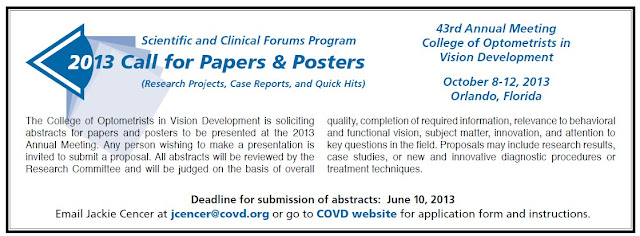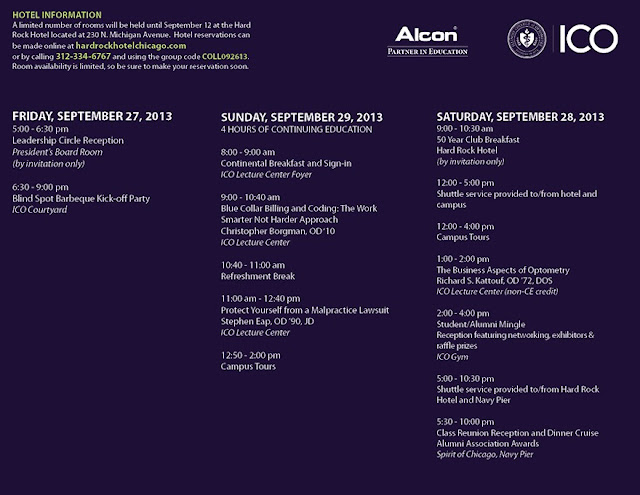Gender Differences In Brain Anatomy Of Dyslexia
Using MRI, neuroscientists at Georgetown University Medical Center found significant differences in brain anatomy when comparing men and women with dyslexia to their non-dyslexic control groups, suggesting that the disorder may have a different brain-based manifestation based on sex. ....
MainosMemos contains the latest research and information about eye and vision care of children, developmental disabilities, Traumatic/Acquired Brain Injury and other topics of interest to me (and hopefully you!).
Saturday, May 25, 2013
CALL FOR PAPERS and Posters: International Conference of Behavioral Optometry
CALL FOR PAPERS
The International Conference of Behavioral Optometry is soliciting abstracts for papers and posters to be presented at the 2014 Meeting. Any person wishing to make a presentation is invited to submit a proposal as outlined below.
Proposals may include research results, case studies, or new and innovative diagnostic procedures or treatment techniques. Abstracts will be accepted as oral or poster presentations. Presenting authors must be registered participants and attend the meeting.
Submission of an abstract acknowledges your acceptance for the abstract to be published in all printed material of the Meeting Abstracts will be published in Optometry & Visual Performance.
Abstracts must be original and must not have been published or presented at any other meeting prior to the ICBO 2014 Meeting.
Abstracts must be submitted in English
All studies must have been approved by institutional committees on ethics of experimental and human investigations
Abstract title - limited to 20 words
Abstract text - limited to 350 words, including acknowledgements.
Abstracts of research projects should clearly state:
Background and aims
Methods
Results
Conclusions
Abstracts of case reports should clearly state:
patient’s symptoms, findings, diagnosis, treatments outcomes
Abstracts of diagnostic or therapeutic techniques should clearly describe:
the procedure, its applications, its unique or innovative characteristics.
Use only standard abbreviations; place special or unusual abbreviations in parentheses after the full word appears the first time. Use generic names of drugs. Express numbers as numerals.
Conflicts of Interest / Disclosure: Work submitted for presentation must include an acknowledgement of funding sources of commercial nature and/or consulting or holding of significant equity in a company that could be affected by the results of the study
THEME OF THE MEETING: Vision is the brain’s way of touching.
To maximize consideration for inclusion in the meeting you may choose to align your topic to the above stated theme or the tenets of behavioral vision care which follow:
The primary purpose of the visual process is the direction of action.
Most movement is visually guided.
Most visual problems are problems of omission, not commission.
SELECTION CRITERIA Each abstract will be reviewed for the following elements: (1) scientific and clinical quality; (2) broad appeal to the interests of the meeting attendees; (3) multidisciplinary nature; (4) timeliness of the topic.
Each complete submission received by December 1, 2013 will be independently peer-reviewed and rated on a blind evaluation basis.
First authors will be notified of acceptance or rejection by March 1, 2014.
AVOIDANCE OF COMMERCIALISM
All presentations must avoid commercialism. Presentations that constitute promotion and advertising will be prohibited. This specifically includes pervasive and inappropriate use of logos. No advertising matter of any description may be distributed. No material may be displayed that in any way directly promotes the commercial interest of any particular company or enterprise, or of the author(s)/presenter(s).
If the cost of presentation has been underwritten to any extent, a clear acknowledgment stating support and identifying the particular source should be included (e.g., "The support of [name of corporation/institute] for this project is gratefully acknowledged.")
ALL accepted presenters/authors/speakers are required to register for the conference, and are fully responsible for all of their expenses related to the conference (e.g., registration, airfare, hotel, meals).
Deadline for submission of abstracts: December 1, 2013 Submit electronically to: [email protected]
Call for Posters
RULES FOR SUBMISSION
Please follow the instructions listed in this website step-by-step
o Abstracts will be accepted as oral or poster presentations
o Abstracts submitted by fax will not be accepted
o Presenting authors must be registered participants and attend the meeting
o Submission of an abstract acknowledges your acceptance for the abstract to be published in all printed material of the Meeting o Abstracts will be published in The Journal of Behavioral Optometry.
o Abstracts must be original and must not have been published or presented at any other meeting prior to the ICBO 2014 Meeting
o Abstracts must be submitted in English
o Conflicts of Interest / Disclosure: Work submitted for presentation must include an acknowledgement of funding sources of commercial nature and/or consulting or holding of significant equity in a company that could be affected by the results of the study
o All studies must have been approved by institutional committees on ethics of experimental and human investigations
ABSTRACT PREPARATION
Before you begin, please prepare the following information:
o Presenting author's contact details
o Email address
o Full postal address
o Daytime and evening phone number
o Author and co-authors' details o Full first and family name(s).
o Authors’ names must be in upper and lower case (J.J.C. Smith).
o Affiliation details: department, institution / hospital, city, state (if relevant), country
o Abstract title - limited to 20 words
o Abstract text - limited to 350 words, including acknowledgements.
o Abstracts of research projects should clearly state:
o Background and aims
o Methods
o Results
o Conclusions
o Abstracts of case reports should clearly state:
o patient’s symptoms
o findings, diagnosis
o treatments o outcomes
o Abstracts of diagnostic or therapeutic techniques should clearly describe:
o the procedure o its applications
o its unique or innovative characteristics.
o Use only standard abbreviation; place special or unusual abbreviations in parentheses after the full word appears the first time.
o Use generic names of drugs. Express numbers as numerals.
THEME OF THE MEETING: Vision is the brain’s way of touching.
To maximize consideration for inclusion in the meeting you may choose to align your topic to the above stated theme or the tenets of behavioral vision care which follow:
o The primary purpose of the visual process is the direction of action.
o Most movement is visually guided.
o Most visual problems are problems of omission, not commission.
ABSTRACT SELECTION AND PRESENTATION
o Each abstract will be reviewed for the following elements:
(1) scientific and clinical quality;
(2) broad appeal to the interests of the membership;
(3) multidisciplinary nature;
(4) timeliness of the topic.
Each complete submission received by December 1, 2013 will be independently peer-reviewed and rated on a blind evaluation basis.
Submit electronically to: [email protected]
All abstracts will be reviewed by the Scientific Program Committee.
Presenting authors will be notified by March 1, 2014 regarding the status of their abstract
International Conference of Behavioral Optometry
September 11-14, 2014 Birmingham, UK
The International Conference of Behavioral Optometry is soliciting abstracts for papers and posters to be presented at the 2014 Meeting. Any person wishing to make a presentation is invited to submit a proposal as outlined below.
Proposals may include research results, case studies, or new and innovative diagnostic procedures or treatment techniques. Abstracts will be accepted as oral or poster presentations. Presenting authors must be registered participants and attend the meeting.
Submission of an abstract acknowledges your acceptance for the abstract to be published in all printed material of the Meeting Abstracts will be published in Optometry & Visual Performance.
Abstracts must be original and must not have been published or presented at any other meeting prior to the ICBO 2014 Meeting.
Abstracts must be submitted in English
All studies must have been approved by institutional committees on ethics of experimental and human investigations
Abstract title - limited to 20 words
Abstract text - limited to 350 words, including acknowledgements.
Abstracts of research projects should clearly state:
Background and aims
Methods
Results
Conclusions
Abstracts of case reports should clearly state:
patient’s symptoms, findings, diagnosis, treatments outcomes
Abstracts of diagnostic or therapeutic techniques should clearly describe:
the procedure, its applications, its unique or innovative characteristics.
Use only standard abbreviations; place special or unusual abbreviations in parentheses after the full word appears the first time. Use generic names of drugs. Express numbers as numerals.
Conflicts of Interest / Disclosure: Work submitted for presentation must include an acknowledgement of funding sources of commercial nature and/or consulting or holding of significant equity in a company that could be affected by the results of the study
THEME OF THE MEETING: Vision is the brain’s way of touching.
To maximize consideration for inclusion in the meeting you may choose to align your topic to the above stated theme or the tenets of behavioral vision care which follow:
The primary purpose of the visual process is the direction of action.
Most movement is visually guided.
Most visual problems are problems of omission, not commission.
SELECTION CRITERIA Each abstract will be reviewed for the following elements: (1) scientific and clinical quality; (2) broad appeal to the interests of the meeting attendees; (3) multidisciplinary nature; (4) timeliness of the topic.
Each complete submission received by December 1, 2013 will be independently peer-reviewed and rated on a blind evaluation basis.
First authors will be notified of acceptance or rejection by March 1, 2014.
AVOIDANCE OF COMMERCIALISM
All presentations must avoid commercialism. Presentations that constitute promotion and advertising will be prohibited. This specifically includes pervasive and inappropriate use of logos. No advertising matter of any description may be distributed. No material may be displayed that in any way directly promotes the commercial interest of any particular company or enterprise, or of the author(s)/presenter(s).
If the cost of presentation has been underwritten to any extent, a clear acknowledgment stating support and identifying the particular source should be included (e.g., "The support of [name of corporation/institute] for this project is gratefully acknowledged.")
ALL accepted presenters/authors/speakers are required to register for the conference, and are fully responsible for all of their expenses related to the conference (e.g., registration, airfare, hotel, meals).
Deadline for submission of abstracts: December 1, 2013 Submit electronically to: [email protected]
Call for Posters
RULES FOR SUBMISSION
Please follow the instructions listed in this website step-by-step
o Abstracts will be accepted as oral or poster presentations
o Abstracts submitted by fax will not be accepted
o Presenting authors must be registered participants and attend the meeting
o Submission of an abstract acknowledges your acceptance for the abstract to be published in all printed material of the Meeting o Abstracts will be published in The Journal of Behavioral Optometry.
o Abstracts must be original and must not have been published or presented at any other meeting prior to the ICBO 2014 Meeting
o Abstracts must be submitted in English
o Conflicts of Interest / Disclosure: Work submitted for presentation must include an acknowledgement of funding sources of commercial nature and/or consulting or holding of significant equity in a company that could be affected by the results of the study
o All studies must have been approved by institutional committees on ethics of experimental and human investigations
ABSTRACT PREPARATION
Before you begin, please prepare the following information:
o Presenting author's contact details
o Email address
o Full postal address
o Daytime and evening phone number
o Author and co-authors' details o Full first and family name(s).
o Authors’ names must be in upper and lower case (J.J.C. Smith).
o Affiliation details: department, institution / hospital, city, state (if relevant), country
o Abstract title - limited to 20 words
o Abstract text - limited to 350 words, including acknowledgements.
o Abstracts of research projects should clearly state:
o Background and aims
o Methods
o Results
o Conclusions
o Abstracts of case reports should clearly state:
o patient’s symptoms
o findings, diagnosis
o treatments o outcomes
o Abstracts of diagnostic or therapeutic techniques should clearly describe:
o the procedure o its applications
o its unique or innovative characteristics.
o Use only standard abbreviation; place special or unusual abbreviations in parentheses after the full word appears the first time.
o Use generic names of drugs. Express numbers as numerals.
THEME OF THE MEETING: Vision is the brain’s way of touching.
To maximize consideration for inclusion in the meeting you may choose to align your topic to the above stated theme or the tenets of behavioral vision care which follow:
o The primary purpose of the visual process is the direction of action.
o Most movement is visually guided.
o Most visual problems are problems of omission, not commission.
ABSTRACT SELECTION AND PRESENTATION
o Each abstract will be reviewed for the following elements:
(1) scientific and clinical quality;
(2) broad appeal to the interests of the membership;
(3) multidisciplinary nature;
(4) timeliness of the topic.
Each complete submission received by December 1, 2013 will be independently peer-reviewed and rated on a blind evaluation basis.
Submit electronically to: [email protected]
All abstracts will be reviewed by the Scientific Program Committee.
Presenting authors will be notified by March 1, 2014 regarding the status of their abstract
Friday, May 24, 2013
The effect of amblyopia treatment on stereoacuity
The effect of amblyopia treatment on stereoacuity
....Stereoacuity improved for almost one half of the study participants. Improvement was observed in both treatment phases. Factors associated with poor or nil stereoacuity at study entry and exit were poor visual acuity of the amblyopic eye and large-angle strabismus.....
....Stereoacuity improved for almost one half of the study participants. Improvement was observed in both treatment phases. Factors associated with poor or nil stereoacuity at study entry and exit were poor visual acuity of the amblyopic eye and large-angle strabismus.....
Thursday, May 23, 2013
Astigmatism and its role in emmetropization
Astigmatism and its role in emmetropization
Astigmatism is a common refractive error caused by the difference in refractive power of the eye along different meridians. This causes two line foci that cannot be corrected by changing viewing distance or accommodation. Although human studies have ascribed astigmatism to multiple factors, its cause remains unclear. Studies in chicks and monkeys suggest that imposed astigmatic error may alter emmetropization, but McLean and Wallman (2003) showed that the early compensatory response to spherical defocus was not affected by concurrent high astigmatism in chicks. This review will focus on possible mechanisms leading to astigmatism and the influence of astigmatism on emmetropization in animal studies.
Astigmatism is a common refractive error caused by the difference in refractive power of the eye along different meridians. This causes two line foci that cannot be corrected by changing viewing distance or accommodation. Although human studies have ascribed astigmatism to multiple factors, its cause remains unclear. Studies in chicks and monkeys suggest that imposed astigmatic error may alter emmetropization, but McLean and Wallman (2003) showed that the early compensatory response to spherical defocus was not affected by concurrent high astigmatism in chicks. This review will focus on possible mechanisms leading to astigmatism and the influence of astigmatism on emmetropization in animal studies.
Kids With Autism Quick To Detect Motion
Kids With Autism Quick To Detect Motion
...Children with autism see simple movements twice as fast as other children their age, a new study finds....Researchers at Vanderbilt University and the University of Rochester were looking to test a common theory about autism which holds that overwhelming sensory stimulation inhibits other brain functions. The researchers figured they could check that by studying how kids with autism process moving images....
Comments: Click on title above to read full story. DM
...Children with autism see simple movements twice as fast as other children their age, a new study finds....Researchers at Vanderbilt University and the University of Rochester were looking to test a common theory about autism which holds that overwhelming sensory stimulation inhibits other brain functions. The researchers figured they could check that by studying how kids with autism process moving images....
Comments: Click on title above to read full story. DM
ICO 170th Commencement 2013
Illinois College of Optometry 170th Commencement Ceremonies
Rockefeller Chapel, University of Chicago
Rockefeller Chapel, University of Chicago
ICO: U.S. Rep. Tammy Duckworth Commencement Address .
Illinois College of Optometry keynote speaker U.S. Rep. Tammy Duckworth 2013 Rockefeller Chapel, University of Chicago
Wednesday, May 22, 2013
How Autism Is Different in Girls vs. Boys
How Autism Is Different in Girls vs. Boys
....Why do boys get diagnosed with autism four times as often as girls?
New research, including some of the latest data from the International Society for Autism Research annual conference last week, addresses this question, one of the biggest mysteries in this field. A growing consensus is arguing that sex differences exist in genetic susceptibility, brain development and social learning in autism—and they are meaningful to our understanding of the disorder and how it will be treated.....
Comments: To read the whole story, click on the title above. DM
....Why do boys get diagnosed with autism four times as often as girls?
New research, including some of the latest data from the International Society for Autism Research annual conference last week, addresses this question, one of the biggest mysteries in this field. A growing consensus is arguing that sex differences exist in genetic susceptibility, brain development and social learning in autism—and they are meaningful to our understanding of the disorder and how it will be treated.....
Comments: To read the whole story, click on the title above. DM
Tuesday, May 21, 2013
Anisometropia and amblyopia in nasolacrimal duct obstruction
Kipp MA, Kipp MA Jr, Struthers W. Anisometropia and amblyopia in nasolacrimal duct obstruction. J AAPOS. 2013 Apr 18. pii: S1091-8531(13)00079-7. doi: 10.1016/j.jaapos.2012.11.022. [Epub ahead of print]
....Anisometropia occurred at a greater rate in unilateral NLDO patients compared with bilateral NLDO patients and occurred at a greater rate in this NLDO cohort than expected in the general pediatric population. Several patients with anisometropia developed clinical amblyopia. Measurement of cycloplegic refraction in all NLDO patients at initial examination should be considered. Periodic follow-up is appropriate for patients with NLDO and anisometropia....
Comments: I have worked with D. Kipp (the younger). He is an outstanding pediatric ophthalmologist and surgeon. This article certainly suggests that any child with unilateral nasolacrimal duct obstruction should be watched for other eye and vision problems developing as they become more mature. Thanks to Drs Kipp, Kipp and Struthers for a fine study!! DM
Monday, May 20, 2013
Optometry & Visual Peformance Now Available
Volume 1,
Issue 3 of Optometry
& Visual Performance
is now available! Enjoy.
Editorial: ADHD: A Parent's Perspective by Marc B. Taub, OD, MS
Article: Experimental Simulation of the Yips for the 3-ft Puttby Mohammed Shahid, BS, Rahma S. Ismail, BS, Dhananjay Tanikella, BS, Akshay Sridhar, MS, George K. Hung, PhD, and Kenneth J. Cuiffreda, OD, PhD
Article: Effects on Accommodation and Symptoms of Yellow-Tinted, Low Plus Lenses
by James Kundart, OD, MEd, John R. Hayes, PhD, Yu-Chi Tai, PhD, and James E. Sheedy, OD, PhD
Article: Evaluating Fall Risk in People with Low Vision: A Case Series
by Kierstyn Napier-Dovorany, OD, and Victoria Graham, DPT
Article: Patients with Paranoid Symptoms: Considerations for the Optometrist
by Mark Bampton, MS, and Maryke N. Neiberg, OD
Upcoming Events
Editorial: ADHD: A Parent's Perspective by Marc B. Taub, OD, MS
Article: Experimental Simulation of the Yips for the 3-ft Puttby Mohammed Shahid, BS, Rahma S. Ismail, BS, Dhananjay Tanikella, BS, Akshay Sridhar, MS, George K. Hung, PhD, and Kenneth J. Cuiffreda, OD, PhD
Article: Effects on Accommodation and Symptoms of Yellow-Tinted, Low Plus Lenses
by James Kundart, OD, MEd, John R. Hayes, PhD, Yu-Chi Tai, PhD, and James E. Sheedy, OD, PhD
Article: Evaluating Fall Risk in People with Low Vision: A Case Series
by Kierstyn Napier-Dovorany, OD, and Victoria Graham, DPT
Article: Patients with Paranoid Symptoms: Considerations for the Optometrist
by Mark Bampton, MS, and Maryke N. Neiberg, OD
Upcoming Events
NIH:FLU IN PREGNANCY MAY QUADRUPLE CHILD’S RISK FOR BIPOLAR DISORDER
FLU IN PREGNANCY MAY QUADRUPLE CHILD’S RISK FOR BIPOLAR DISORDER
Pregnant mothers’ exposure to the flu was associated with a nearly fourfold increased risk that their child would develop bipolar disorder <http://www.nimh.nih.gov/health/topics/bipolar-disorder/index.shtml> in adulthood, in a study funded by the National Institutes of Health. The findings add to mounting evidence of possible shared underlying causes and illness processes with schizophrenia <http://www.nimh.nih.gov/health/topics/schizophrenia/index.shtml>, which some studies have also linked to prenatal exposure to influenza.
“Prospective mothers should take common sense preventive measures, such as getting flu shots prior to and in the early stages of pregnancy and avoiding contact with people who are symptomatic,” said Alan Brown, M.D., M.P.H, of Columbia University and New York State Psychiatric Institute, a grantee of the NIH’s National Institute of Mental Health (NIMH). “In spite of public health recommendations, only a relatively small fraction of such women get immunized. The weight of evidence now suggests that benefits of the vaccine likely outweigh any possible risk to the mother or newborn.”
Brown and colleagues reported their findings online May 8, 2013 in JAMA Psychiatry.
Although there have been hints of a maternal influenza/bipolar disorder connection, the new study is the first to prospectively follow families in the same HMO, using physician-based diagnoses and structured standardized psychiatric measures. Access to unique Kaiser-Permanente, county and Child Health and Development Study <http://www.chdstudies.org/> databases made it possible to include more cases with detailed maternal flu exposure information than in previous studies.
Among nearly a third of all children born in a northern California county during 1959-1966, researchers followed, 92 who developed bipolar disorder, comparing rates of maternal flu diagnoses during pregnancy with 722 matched controls.
The nearly fourfold increased risk implicated influenza infection at any time during pregnancy, but there was evidence suggesting slightly higher risk if the flu occurred during the second or third trimesters. Moreover, the researchers linked flu exposure to a nearly sixfold increase in a subtype of bipolar disorder with psychotic features.
A previous study, by Brown and colleagues, in a related northern California sample, found a threefold increased risk for schizophrenia associated with maternal influenza during the first half of pregnancy. Autism has similarly been linked to first trimester maternal viral infections and to possibly related increases in inflammatory molecules.
“Future research might investigate whether this same environmental risk factor might give rise to different disorders, depending on how the timing of the prenatal insult affects the developing fetal brain,” suggested Brown.
Bipolar disorder shares with schizophrenia a number of other suspected causes and illness features, the researchers note. For example, both share onset of symptoms in early adulthood, susceptibility genes <http://www.nimh.nih.gov/news/science-news/2009/schizophrenia-and-bipolar-disorder-share-genetic-roots.shtml>, run in the same families, affect nearly one percent of the population, show psychotic behaviors and respond to antipsychotic medications.
Increasing evidence of such overlap between traditional diagnostic categories has led to the NIMH Research Domain Criteria (RDoC) <http://www.nimh.nih.gov/about/director/2013/transforming-diagnosis.shtml> project, which is laying the foundation for a new mental disorders classification system based on brain circuits and dimensional mechanisms that cut across traditional diagnostic categories.
The research was also funded by NIH’s Eunice Kennedy Shriver National Institute of Child Health and Human Development (NICHD).
The mission of the NIMH is to transform the understanding and treatment of mental illnesses through basic and clinical research, paving the way for prevention, recovery and cure. For more information, visit <http://www.nimh.nih.gov>.
About the Eunice Kennedy Shriver National Institute of Child Health and Human Development (NICHD): The NICHD sponsors research on development, before and after birth; maternal, child, and family health; reproductive biology and population issues; and medical rehabilitation. For more information, visit the Institute’s website at <http://www.nichd.nih.gov/>.
About the National Institutes of Health (NIH): NIH, the nation's medical research agency, includes 27 Institutes and Centers and is a component of the U.S. Department of Health and Human Services. NIH is the primary federal agency conducting and supporting basic, clinical, and translational medical research, and is investigating the causes, treatments, and cures for both common and rare diseases. For more information about NIH and its programs, visit <www.nih.gov>.
NIH...Turning Discovery into Health -- Registered, U.S. Patent and Trademark Office
---------------------
REFERENCE:
Gestational Influenza and bipolar Disorder in Adult Offspring. Parboosing R, Bao Y, Shen L, Schaefer CA, Brown AS. JAMA Psychiatry, May 8, 2013.
--------------------------------
Pregnant mothers’ exposure to the flu was associated with a nearly fourfold increased risk that their child would develop bipolar disorder <http://www.nimh.nih.gov/health/topics/bipolar-disorder/index.shtml> in adulthood, in a study funded by the National Institutes of Health. The findings add to mounting evidence of possible shared underlying causes and illness processes with schizophrenia <http://www.nimh.nih.gov/health/topics/schizophrenia/index.shtml>, which some studies have also linked to prenatal exposure to influenza.
“Prospective mothers should take common sense preventive measures, such as getting flu shots prior to and in the early stages of pregnancy and avoiding contact with people who are symptomatic,” said Alan Brown, M.D., M.P.H, of Columbia University and New York State Psychiatric Institute, a grantee of the NIH’s National Institute of Mental Health (NIMH). “In spite of public health recommendations, only a relatively small fraction of such women get immunized. The weight of evidence now suggests that benefits of the vaccine likely outweigh any possible risk to the mother or newborn.”
Brown and colleagues reported their findings online May 8, 2013 in JAMA Psychiatry.
Although there have been hints of a maternal influenza/bipolar disorder connection, the new study is the first to prospectively follow families in the same HMO, using physician-based diagnoses and structured standardized psychiatric measures. Access to unique Kaiser-Permanente, county and Child Health and Development Study <http://www.chdstudies.org/> databases made it possible to include more cases with detailed maternal flu exposure information than in previous studies.
Among nearly a third of all children born in a northern California county during 1959-1966, researchers followed, 92 who developed bipolar disorder, comparing rates of maternal flu diagnoses during pregnancy with 722 matched controls.
The nearly fourfold increased risk implicated influenza infection at any time during pregnancy, but there was evidence suggesting slightly higher risk if the flu occurred during the second or third trimesters. Moreover, the researchers linked flu exposure to a nearly sixfold increase in a subtype of bipolar disorder with psychotic features.
A previous study, by Brown and colleagues, in a related northern California sample, found a threefold increased risk for schizophrenia associated with maternal influenza during the first half of pregnancy. Autism has similarly been linked to first trimester maternal viral infections and to possibly related increases in inflammatory molecules.
“Future research might investigate whether this same environmental risk factor might give rise to different disorders, depending on how the timing of the prenatal insult affects the developing fetal brain,” suggested Brown.
Bipolar disorder shares with schizophrenia a number of other suspected causes and illness features, the researchers note. For example, both share onset of symptoms in early adulthood, susceptibility genes <http://www.nimh.nih.gov/news/science-news/2009/schizophrenia-and-bipolar-disorder-share-genetic-roots.shtml>, run in the same families, affect nearly one percent of the population, show psychotic behaviors and respond to antipsychotic medications.
Increasing evidence of such overlap between traditional diagnostic categories has led to the NIMH Research Domain Criteria (RDoC) <http://www.nimh.nih.gov/about/director/2013/transforming-diagnosis.shtml> project, which is laying the foundation for a new mental disorders classification system based on brain circuits and dimensional mechanisms that cut across traditional diagnostic categories.
The research was also funded by NIH’s Eunice Kennedy Shriver National Institute of Child Health and Human Development (NICHD).
The mission of the NIMH is to transform the understanding and treatment of mental illnesses through basic and clinical research, paving the way for prevention, recovery and cure. For more information, visit <http://www.nimh.nih.gov>.
About the Eunice Kennedy Shriver National Institute of Child Health and Human Development (NICHD): The NICHD sponsors research on development, before and after birth; maternal, child, and family health; reproductive biology and population issues; and medical rehabilitation. For more information, visit the Institute’s website at <http://www.nichd.nih.gov/>.
About the National Institutes of Health (NIH): NIH, the nation's medical research agency, includes 27 Institutes and Centers and is a component of the U.S. Department of Health and Human Services. NIH is the primary federal agency conducting and supporting basic, clinical, and translational medical research, and is investigating the causes, treatments, and cures for both common and rare diseases. For more information about NIH and its programs, visit <www.nih.gov>.
NIH...Turning Discovery into Health -- Registered, U.S. Patent and Trademark Office
---------------------
REFERENCE:
Gestational Influenza and bipolar Disorder in Adult Offspring. Parboosing R, Bao Y, Shen L, Schaefer CA, Brown AS. JAMA Psychiatry, May 8, 2013.
--------------------------------
Sunday, May 19, 2013
Outcomes of surgery in children with early-onset exotropia
Outcomes of surgery in children with early-onset exotropia
.....[this study's purpose was to]....evaluate the clinical characteristics and surgical outcomes of early-onset exotropia and to compare differences between constant and intermittent exotropia......The mean age of onset of exodeviation in 45 patients was 9.3±3.8 months. Mean age at surgery was 4.5±2.4 years, and the mean postoperative follow-up period was 17.3 months .... 23% showed non-alignment of more than±10 prism diopters (PD).....bifixation developed in 10 patients (29%). .....
Comments: Once again post strabismus surgical outcomes show a high percentage of children with poor outcomes. Please note that this study put a positive spin on its outcomes ....but no matter how you tell the story of strabismus surgery, it always has up to 1/3 not being helped. Use caution when recommending surgery, especially if you do not do vision therapy first. DM
.....[this study's purpose was to]....evaluate the clinical characteristics and surgical outcomes of early-onset exotropia and to compare differences between constant and intermittent exotropia......The mean age of onset of exodeviation in 45 patients was 9.3±3.8 months. Mean age at surgery was 4.5±2.4 years, and the mean postoperative follow-up period was 17.3 months .... 23% showed non-alignment of more than±10 prism diopters (PD).....bifixation developed in 10 patients (29%). .....
Comments: Once again post strabismus surgical outcomes show a high percentage of children with poor outcomes. Please note that this study put a positive spin on its outcomes ....but no matter how you tell the story of strabismus surgery, it always has up to 1/3 not being helped. Use caution when recommending surgery, especially if you do not do vision therapy first. DM
Subscribe to:
Posts (Atom)





